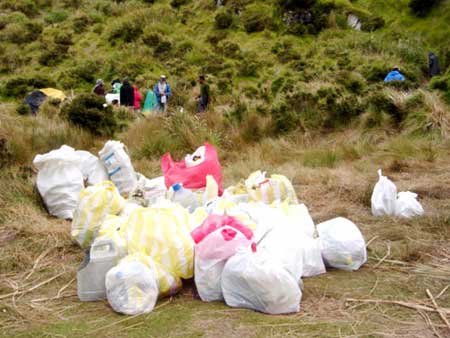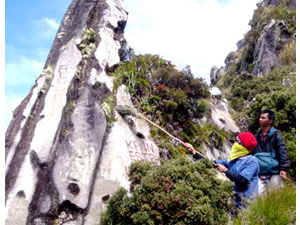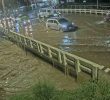Although the amount of garbage collected during this year�s clean-up drive has significantly decreased compared to the summer of 2000, trash left behind by irresponsible trekkers still accumulate on Mount Apo.

By Keith Bacongco
davaotoday.com
KIDAPAWAN CITY — Despite the campaign by the local government and some nongovernment organizations to maintain cleanliness on the country’s highest peak, garbage continue to pile up at the Mount Apo natural park.
Although the amount of garbage collected during this year�s clean-up drive has significantly decreased compared to the summer of 2000, trash left behind by irresponsible trekkers still accumulate on Mount Apo.
Ermelo Libre, executive director of the Mount Apo Foundation Inc., told davaotoday.com that there is a big improvement in the collection of garbage on Mount Apo. “Way back in 2000, we hauled 1.5 tons at Venado lake and around 30 sacks of assorted garbage at the peak,� Libre said. �Comparatively, the garbage and graffiti have decreased tremendously. I give credit to LGUs that religiously conducted pre-climb orientation and onsite monitoring of climbers activities.”
 From April 19 to 21, MAFI, along with at least 20 volunteers, conducted garbage collection and graffiti cleanup. The team gathered 195 kilos of garbage, including bottles.
From April 19 to 21, MAFI, along with at least 20 volunteers, conducted garbage collection and graffiti cleanup. The team gathered 195 kilos of garbage, including bottles.
The volunteers used wet cement to wipe out the graffiti on the boulders at the peak.
Most of the garbage left by climbers were cellophanes, food wrappers, tin cans and bottles of softdrinks and liquors. Some of these garbage were hidden under the thick grasses and even buried in the ground.
Libre stressed that policy enforcement must be strengthened on the Mount Apo Natural Park. “If enforcement of the policy is lax, violators will flourish because there is no disincentive in doing what is prohibited,” he said.
Rodion Palma Gil, president of Sandawa Apo Mountaineering and Ecology Club (SAMEC) in Davao City, blamed irresponsible climbers for the proliferation of garbage in Mount Apo.
“Most of these irresponsible climbers are the ones responsible for this. They lack training or knowledge on Basic Mountaineering Course (BMC),” Palma Gil said in an interview.
He suggested that there should be proper monitoring of the trekkers in all the entry points of the mountain. “Otherwise, these irresponsible trekkers will keep on leaving their wastes behind.”
Although the local government units around the natural park are doing their part in the information campaign, such as pre-climb orientations, Libre refused to comment if the LGUs had lapses in enforcing the rules and regulation in climbing Mount Apo.
But he said that regular park employees or deputized agents from LGUs and the Department of Environment and Natural Resources (DENR) must be manning the converging areas (Lake Venado and the peak) and various trails. “But this is more of a wish than a reality unless all LGUs sit down and forge an alliance to preserve and protect Mount Apo.”
The Protected Area Management Board (PAMB) of the DENR closed designated areas of Mt. Apo National Park to all climbers and trekkers for two years starting May 31, 2000 but has since extended this indefinitely.
The area was ordered closed in 2000 to prevent further the destruction and depletion of its resources.
In 2004, the Sta. Cruz trail in Davao Del Sur was re-opened to trekkers while the Kidapawan City trail was re-opened in 2005. Last year, Digos-Kapatagan trail was temporarily opened to test their climbing policy and system.
At 10,311 feet above sea level, Mount Apo is home to some 800 animal and plant species. For the Lumads living around the mountain, Apo Sandawa � their name for Mount Apo — is a sacred place. (Keith Bacongco/davaotoday.com)










